Jon Evans discovers the microbes hard at work on our behalf, extracting valuable metals from low-grade ore
When you think of mining, you tend to think of huge pits in the ground, massive machinery and men with lights on their hardhats descending into the darkness. What you don’t think of is pouring liquid on to mounds of rubble and the largest bioreactors in use today. Welcome to the world of biomining.
Although biomining may not fit the common mining stereotype, it has been a part of industrial metal mining, albeit a niche part, for around 50 years. And just like conventional mining, it still requires digging up rocks and blasting them to bits. The difference is that rather than using heat to then extract the metals from these rocks, biomining uses microbes.
Up to now, biomining has mainly been used to extract copper and gold from rocks where they’re present at low concentrations (around 0.5% or less), known as low-grade ores. Extracting these metals using more energy-intensive heat-based methods, such as smelting, wouldn’t be cost effective. Around 5% of the world’s supply of gold and 20% of its copper is currently extracted using biomining.
But as we gradually use up our remaining deposits of high-grade ore, biomining will increasingly come to the fore. Biomining is already being used to extract more metals from more materials in more places. Eventually, microbes might even follow human miners down into the darkness.
Rock-munchers
Biomining takes advantage of microbes that eat rocks, or lithotrophs. The first example of such a rock-munching microbe, now known as Acidithiobacillus ferrooxidans, was discovered in the 1940s, but many more microbes, specifically species of bacteria and archaea, have been discovered since then. Whereas normal microbes obtain energy from sunlight or by breaking down organic compounds, rock-eating microbes get theirs by breaking down the minerals in rocks.
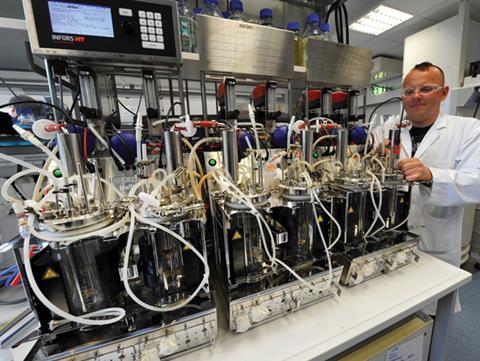
In most cases, the microbes break down these minerals by oxidising the sulfur and iron within them. Because metals such as copper, nickel and zinc naturally form sulfides, while other metals such as gold are trapped, or occluded, within sulfide- and iron-containing minerals, this oxidation process ends up releasing the metals.
While most of the metals in these rocks are released via the oxidation of sulfides, it is actually the iron-oxidising microbes that perform that most important role. This is because the iron found in common minerals, such as pyrite (FeS2), is in the form Fe2+, known as ferrous iron, which the microbes oxidise to ferric iron (Fe3+), and this form is very effective at oxidising sulfides.
This means that the main contribution of the sulfur-oxidising microbes isn’t oxidising the metal sulfides directly but oxidising sulfur-containing compounds released from the breakdown of the minerals. This is a central part of the process, however, because it generates sulfuric acid, which solubilises the ferric iron so that it can oxidise the sulfides effectively.
Both iron- and sulfur-oxidising microbes are naturally found in rocks, along with microbes that degrade the organic molecules produced as waste products by the lithotrophic microbes, with many microbes possessing multiple abilities. Biomining simply encourages the growth of microbes that are already in the rocks and collects the released metals (see box below for details).
Heaps, dumps and tanks
There are two basic ways of biomining: bioleaching, which works with rocks that contain metal sulfides; and bio-oxidation, which works with metals that are occluded in sulfur- and iron-containing minerals. Bioleaching takes advantage of the fact that metals released from metal sulfides naturally dissolve in sulfuric acid, producing a metal-rich leachate that can be collected.
This tends to be done by crushing the extracted rocks into small fragments and piling them into heaps up to 10m high. Sulfuric acid is then continually poured over the top of these heaps to encourage the growth of the rock-munching microbes, which are also often added to the acid. The heaps are placed onto a polyethylene lining to collect the metal-rich leachate, while air lines are inserted into the heap to supply oxygen and carbon dioxide.
The released metals are usually extracted from the leachate using a combination of solvent extraction and electrowinning, in which an electric current passing through the leachate causes the metal to come out of solution and plate an electrode. The metal-free leachate is then recirculated back to the heap, having reverted to a microbe-containing acidic solution.
Copper is the main metal extracted using this bioleaching process, particularly from ores containing the mineral chalcocite (Cu2S). Heap bioleaching of copper is currently conducted at 18 sites around the world, concentrated in North and South America and Australia, with the largest at Morenci, Arizona, in the US able to produce 380,000 tonnes of copper a year.
There is also a related technique known as dump bioleaching, which tends to be an offshoot of conventional copper mining operations rather than the main activity, as is usually the case with heap bioleaching. Dump bioleaching involves pouring sulfuric acid over huge piles of discarded low-grade ore up to 60m high and collecting the metal-rich leachate. As a secondary mining activity, dump bioleaching is more primitive and less efficient than heap bioleaching: it works with larger rock fragments and usually doesn’t incorporate polyethylene linings or air lines. This method has been around since the 1960s, while heap bioleaching first appeared in 1980.
Goldbugs
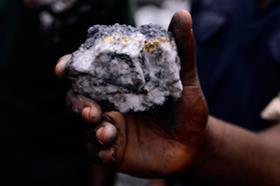
Bio-oxidation is the newest form of biomining, first appearing in 1986. Although using the same microbes and oxidation process as bioleaching, bio-oxidation takes place in huge bioreactors, often placed in series, rather than heaps. Indeed, bio-oxidation uses bioreactors with volumes of more than 1300m3, which are the largest reactors used for any bioprocess in the world. This makes bio-oxidation a more expensive process than bioleaching and so is almost solely used for extracting gold.
Other differences between bio-oxidation and bioleaching are that the former works with a gold-rich concentrate chemically extracted from the rock and releases the gold as tiny solid particles rather than dissolved in a leachate. The concentrate is introduced at one end of a series of bioreactors, each of which contains a solution of rock-munching microbes constantly stirred by agitators to keep the gold concentrate in suspension and to circulate oxygen and carbon dioxide. The end result is a gold-rich residue that is collected from the far end. This residue is neutralised with lime (CaO), separated into solid and liquid fractions, and then gold is recovered from the solid fraction by leaching it with cyanide.
The bio-oxidation of gold currently takes place at 13 sites around the world, mainly in South America, Africa, Australia and China. The largest bio-oxidation operation is in Ashanti, Ghana, which produces around 960 tonnes of gold a year.
Microbial mystery
Biomining in general is much slower than conventional processing techniques. ‘The downside is time,’ admits Barrie Johnson, professor of environmental biotechnology at Bangor University, UK. ‘Biomining is much slower than pyrometallurgy [smelting]. A dump operation might take five years to get the copper out, a heap operation might take six to 12 months, and a tank might take between three and five days.’
We don’t really understand exactly which micro-organisms do what in the heaps
Corale Brierley
What exactly happens during this time is still something of a mystery. For a start, scientists don’t really understand much about the biochemical pathways used by the microbes to break down minerals. Adding to the confusion is that different species seem to take different approaches; for example, some microbes oxidise iron at the cell surface while others do it inside the cell.
Even more surprisingly, they’re not even sure about which microbes take part. This is especially the case for heap mining, where up to 30 different microbial species may be present in the heap. This diversity is a result both of the heap being open to the environment and of conditions such as temperature and acidity varying greatly between different parts of the heap.
‘We don’t really understand exactly which micro-organisms do what in the heaps,’ says Corale Brierley, a US biomining consultant. ‘It’s the ores and the conditions in the heaps that select for the types of micro-organisms that are going to grow.’
In contrast, conditions are much more controlled in the bioreactors used for bio-oxidation, which tend to contain just four or five introduced microbial species, comprising a mixture of iron- and sulfur-oxidisers and consumers of organic compounds. Even then, however, the distribution of these species throughout the series of bioreactors tends to alter during operation, with sulfur-oxidisers congregating at the start of the series and iron-oxidisers at the end.
What scientists do know is that biomining is the only realistic method for extracting metal from low-grade ores and such ores are going to become an increasingly common feature of industrial mining in the future. ‘Many of the metal deposits which are high-grade and close to the surface have been used,’ says Johnson. ‘It’s very rare for a new ore body to be found that contains a lot of metal.’
This is certainly the case for copper, where low-grade ores now comprise the largest remaining deposits, particularly ores containing the mineral chalcopyrite (CuFeS2). ‘We know that the largest source of copper going forward is a mineral called low-grade chalcopyrite ore and that [accounts for] something like 80% of all copper mineral value,’ says Brierley. Chalcopyrite ores are too low-grade for traditional heat-based extraction techniques such as smelting, but they also present a challenge for biomining, because chalcopyrite is fairly resistant to oxidation by ferric iron.
It’s very rare for a new ore body to be found that contains a lot of metal
Barrie Johnson
The reason for this seems to be that the initial oxidation of chalcopyrite causes it to be covered in some kind of protective layer that prevents further oxidation, and as a consequence only around 30% of the chalcopyrite in a heap can currently be leached. Recent research has shown, however, that conducting oxidation at high temperatures (above 60°C) can resolve this problem, but scientists aren’t sure why. The lithotrophic microbes often used in biomining can’t tolerate these high temperatures, but scientists have recently found that certain heat-loving extremophiles share the ability to oxidise ferrous iron.
These extremophiles potentially offer a way to take advantage of the huge chalcopyrite deposits, although it’s still early days. ‘Companies recognise that that’s their future because they’re going to be running out of the high-grade ore, and so they’re now getting very serious about how to process this by biomining,’ says Brierley.
Cleaning up their act
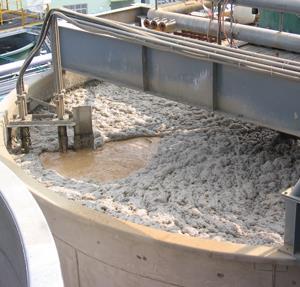
Mining companies are also getting very serious about using biomining to extract other metals from low-grade ores, many of which contain a mixture of potentially extractable metals, such as nickel, zinc and cobalt, at low concentrations. As with copper, these metals can be found in rocks as sulfides, and thus can be extracted by bioleaching. This is what happens at the Talvivaara mine in Finland, where nickel and zinc are extracted from polymetallic black schist ore by heap bioleaching. The mine began operating in 2009 and in 2013 produced around 9000 tonnes of nickel and 17,000 tonnes of zinc.
These metals are not always present as sulfides, however; in some regions, especially in the tropics, they’re more likely to be found as oxides or occluded within oxides. Now, this creates a problem for conventional biomining, because these metals can’t be released from their oxides by further oxidation. Recently, however, a team of scientists, including Johnson, came up with a way to use microbes to reduce these oxides, thereby releasing the metals.
They use the same kind of microbes as conventional biomining, but essentially reverse the whole process by removing the oxygen. Under anaerobic conditions, these microbes still oxidise sulfur-based compounds in the rocks, but rather than do it using oxygen from the air, they do it by reducing ferric iron to ferrous iron, which then naturally reduces the metal oxides. Using this technique, they were able to extract nickel occluded within the oxidised mineral goethite (FeO·OH).
The same approach should work with other oxidised minerals. ‘This opens up a whole new range of possibilities for extending biomining in the future,’ says Johnson. One of those possibilities is using it to extract rare earth metals such as neodymium from low-grade deposits. These metals are essential components of many modern technologies, but their supply is currently dominated by just a few countries with rich, concentrated deposits, such as China.
Another option is using biomining to clean up old, abandoned mines. These mines often contain lots of discarded ore with low concentrations of metal, which at the time could not be economically extracted using conventional techniques, but which are potentially ideal for biomining. ‘Throughout Europe, there’s [mining] waste that contains more metal than we are digging out of the ground as primary ore,’ says Johnson.
Indeed, bioleaching by microbes often occurs naturally in this discarded ore, creating an acidic, metal-rich leachate that can contaminate the surrounding environment. Several projects have successfully used biomining to clean up abandoned mines while extracting valuable metal; for example, an operation at Kasese in Uganda used bioreactors to extract cobalt, zinc, copper and nickel from copper mining waste.
Deeper underground
Perhaps the most exciting possibility, however, is the potential for using biomining to extract metals from deposits that are unreachable. At the moment, mining still involves digging up and crushing huge amounts of rocks, which uses a lot of energy and causes a lot of environmental damage. ‘Breaking up rocks takes about 5% of all the energy we as human beings consume,’ says Johnson.
Furthermore, we can only economically bring up rocks from close to the surface, whereas there is a great deal more metal further down. ‘If you go down a kilometre underground, there’s a lot of metal there,’ says Johnson. ‘But to dig up an ore body from a kilometre underground is very, very expensive.’
Breaking up rocks takes about 5% of all the energy we as human beings consume
Barrie Johnson
So rather than dig up the rocks from deep underground and extract the metal at the surface, microbes could be sent underground to extract the metal and the resultant leachate pumped up to the surface for metal recovery. Not only would this be much less costly and energy-intensive, but there would be minimal environmental disruption at the surface. Indeed, you wouldn’t actually need to send the microbes, you would just need to send down ferric or ferrous iron, depending on whether the metals are sulfides or oxides, which the microbes could produce in a tank at the?surface.
The development of fracking technology for extracting oil from rocks deep underground has helped make this option much more feasible, although it has yet to be tried in practice. Nevertheless, both Johnson and Brierley see it as the future of mining. ‘That’s probably the way we’ll be mining most metals in a 100 years’ time,’ predicts Johnson, although he thinks the technology will be ready before that. Brierley agrees: ‘It may well be 15–20 years before the technology is fully ready for commercial use, [but] in situ mining is one technology that will need to be employed.’
If that’s the case, we may soon think of mining in a completely different light.
Jon Evans is a science writer based in Bosham, UK
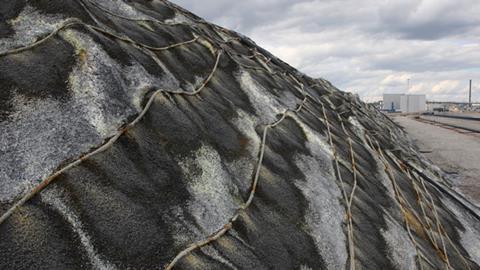





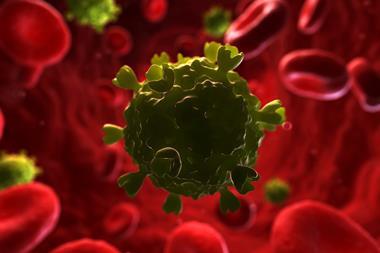






No comments yet